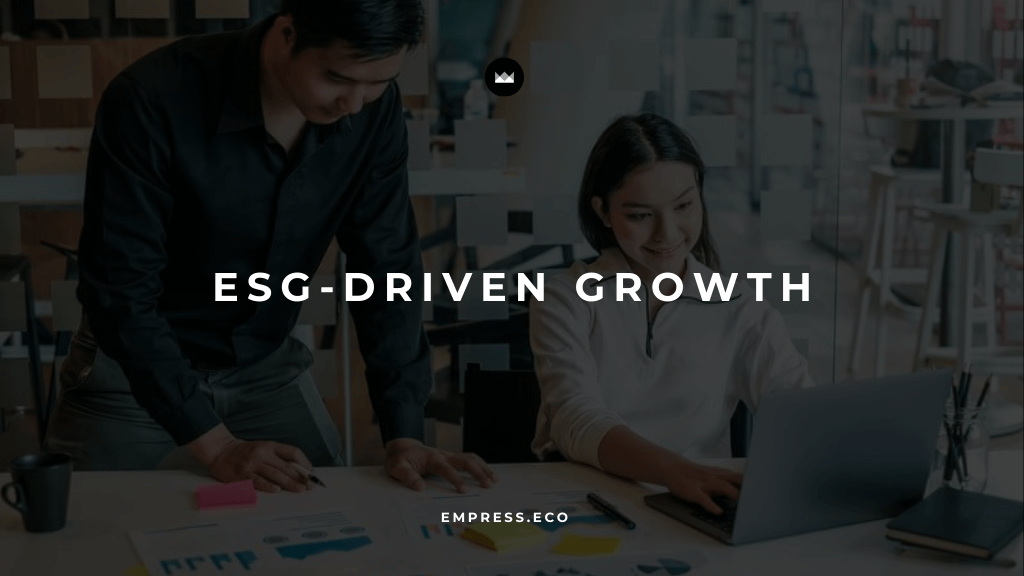
How ESG Integration Drives Sustainable Business Growth and Innovation
Explore how embedding ESG practices can fuel innovation, growth, and competitive advantage.
Table of Contents
Sustainability is no longer just a trend or a “nice-to-have” for companies—it has become a core business strategy that drives growth and innovation. In today's market, businesses are facing more pressure to integrate sustainable practices and take responsibility for their environmental, social, and governance (ESG) impacts. But what many companies are discovering is that this isn't just about staying compliant or looking good in a corporate report. In fact, integrating ESG practices is unlocking new opportunities for growth, innovation, and competitive advantage.
From reducing environmental footprints to improving diversity, equity, and inclusion (DEI) practices, ESG goes beyond just ticking boxes—it’s about making better business decisions that deliver long-term value. Companies that embrace ESG principles aren't just seen as more responsible—they’re seen as more resilient and forward-thinking.
In this blog, we’ll explore how businesses can leverage ESG integration to drive sustainable growth and innovation. We’ll discuss actionable strategies, real-world applications, and how to overcome common challenges in embedding ESG into your business model.
Why ESG Integration Is a Game Changer
Let’s start by defining ESG: Environmental, Social, and Governance factors that guide how businesses operate responsibly. Each pillar has its own unique focus:
- Environmental: How companies interact with and protect the environment. This includes everything from reducing carbon emissions to managing water usage and minimizing waste.
- Social: The impact a company has on people—its employees, customers, communities, and society at large. Social factors include labor practices, diversity and inclusion, and community engagement.
- Governance: This refers to a company’s internal practices and policies, focusing on ethical leadership, transparency, executive compensation, and compliance with laws and regulations.
ESG is more than just a checklist. Companies that truly integrate these principles into their operations can create a competitive edge by managing risks, innovating faster, and building trust with stakeholders, customers, and investors.
Why ESG Integration Drives Competitive Advantage
Here’s the reality: consumers, investors, and even employees are becoming more conscious about sustainability. A company’s commitment to ESG isn’t just a perk—it’s a deciding factor for many stakeholders. Businesses that take their ESG commitments seriously build stronger customer loyalty, attract impact-focused investors, and cultivate a positive brand reputation.
Example: Take Unilever, one of the most prominent companies in the sustainability space. The consumer goods giant has integrated ESG into the core of its operations, from reducing carbon emissions in its supply chain to improving human rights policies. Unilever's Sustainable Living Plan contributed to nearly 70% of its growth over a 10-year period, proving that ESG not only creates value but also fosters innovation.
Actionable Insight: If you want to stay competitive, start embedding ESG principles into every layer of your business—from your supply chain to your boardroom. Not only will this build resilience against external risks, but it will also enhance your brand’s appeal to consumers who value responsible business practices.
Environmental Pillar: How to Turn Sustainability into Innovation
The Environmental aspect of ESG often draws the most attention, and for good reason. The need to address climate change, conserve natural resources, and reduce carbon footprints is more pressing than ever. However, companies that integrate environmental sustainability into their strategies don’t just do so for compliance. They do it to innovate.
Focusing on Energy Efficiency and Clean Technology
One of the first places where businesses can make an immediate impact is by improving energy efficiency and adopting cleaner technologies. Whether it's upgrading to energy-efficient machinery, adopting renewable energy sources, or optimizing supply chains for fuel efficiency, the environmental benefits are clear.
But the financial and operational benefits are equally compelling. For many companies, reducing energy consumption or switching to renewable resources results in significant cost savings over time. Plus, it often opens up access to government incentives or sustainability grants.
Example: Google has been a leader in renewable energy, having matched its energy consumption with 100% renewable energy since 2017. Google’s investment in wind and solar power not only helps the company achieve its sustainability goals but also creates long-term cost savings as renewable energy becomes cheaper than traditional energy sources.
Actionable Insight: Begin with an energy audit of your operations to identify areas where energy efficiency can be improved. From there, explore options like solar panels, wind energy, or simply optimizing your energy usage with smart technologies. These steps will not only cut costs but will demonstrate a commitment to sustainability that resonates with consumers and investors alike.
Redesigning Products for Sustainability
Integrating sustainability into your product design can be a game-changer for both the environment and your bottom line. More consumers are actively seeking out products that are eco-friendly, and many are willing to pay a premium for them. Whether it’s reducing plastic packaging, sourcing sustainable materials, or making products more durable and repairable, sustainable design can spark innovation in every product category.
Example: IKEA is an excellent case in point. The company’s commitment to a circular economy means that it is designing products to be recycled or reused. They’ve even introduced a buy-back program that allows customers to return used furniture for store credit, furthering IKEA’s sustainability goals and strengthening customer loyalty.
Actionable Insight: Conduct a review of your product lifecycle and supply chain. Can you reduce waste, switch to sustainable materials, or offer repair services? Even small changes to your product design can have a significant environmental impact and open new revenue streams by appealing to eco-conscious consumers.
Social Pillar: Prioritizing People to Drive Growth
Moving to the Social pillar, this aspect of ESG focuses on how businesses treat their employees, customers, and the communities they operate in. Social factors are often undervalued in ESG strategies, but companies that excel here understand the direct connection between prioritizing people and business performance.
Building a Diverse and Inclusive Workforce
Research consistently shows that companies with a strong commitment to diversity, equity, and inclusion (DEI) outperform their peers. A more diverse workforce brings a wider range of ideas, experiences, and perspectives, fostering innovation and improving decision-making.
Moreover, promoting DEI is no longer optional for businesses—it’s an expectation. Employees, particularly younger generations, are looking for workplaces where diversity and inclusion are not just values on paper but are embedded in the company culture.
Example: Salesforce is an example of a company leading the way in DEI. The tech giant has implemented policies to close the gender pay gap, achieve racial and gender diversity in leadership roles, and promote inclusive hiring practices. Salesforce also offers DEI training to all employees, reinforcing the idea that an inclusive culture drives both innovation and employee satisfaction.
Actionable Insight: If you haven’t already, start by developing a DEI strategy for your organization. Focus on measurable goals—such as increasing diversity in leadership or addressing pay equity—and track your progress. Ensure you’re creating an inclusive environment where all employees feel valued and supported.
Community Engagement and Corporate Responsibility
Your company’s relationship with its community is a key aspect of the social pillar. Beyond just philanthropy, community engagement involves contributing positively to the local communities where you operate. Whether it’s creating jobs, supporting local education initiatives, or developing partnerships with community organizations, businesses that invest in their communities build stronger relationships and long-term support.
Example: Starbucks has made community engagement a core part of its corporate responsibility strategy. By launching programs like the Starbucks Foundation and creating initiatives for youth employment, Starbucks has built a reputation as a socially responsible company that gives back to the communities it serves.
Actionable Insight: Look for ways to engage meaningfully with the communities around you. This could involve creating mentorship programs, supporting local schools, or sponsoring community events. The goal is to create mutually beneficial relationships that strengthen your brand’s reputation and contribute to social good.
Governance Pillar: Building Ethical and Transparent Leadership
The Governance aspect of ESG deals with how businesses are run—their leadership, internal processes, and commitment to transparency. Strong governance ensures that a company is making ethical decisions that benefit not only shareholders but also employees, customers, and the broader society.
Practicing Transparency and Ethical Leadership
In a world where consumers and investors are demanding more transparency, businesses must prioritize openness about their practices, especially when it comes to ESG. Clear, honest reporting about everything from environmental impact to social initiatives is crucial for building trust.
Transparency also ties into ethical leadership. Companies that prioritize good governance are less likely to face scandals, regulatory fines, or loss of investor confidence.
Example: Ben & Jerry’s is known for its commitment to transparency. The ice cream company publishes detailed reports on its social and environmental efforts, outlining where it succeeds and where it falls short. By being transparent, Ben & Jerry’s has built a loyal customer base that values the company’s mission-driven approach.
Actionable Insight: Ensure that your company is practicing transparency by regularly publishing ESG reports that outline your goals, progress, and challenges. This demonstrates accountability and helps build trust with stakeholders. Make governance a priority by developing clear codes of conduct for all employees, from the C-suite to the front lines.
Developing a Strong Governance Structure
A robust governance structure involves having the right checks and balances in place, ensuring diversity at the board level, and making ethical decisions that align with long-term business goals. By implementing a governance framework that promotes accountability, companies can mitigate risks and foster a culture of integrity.
Example: Johnson & Johnson has a governance structure designed to ensure accountability and uphold its ethical standards. The company’s commitment to strong governance has helped maintain its reputation for quality and reliability, even amid challenges.
Actionable Insight: Review your governance structure to ensure diversity and accountability at every level. Regular audits and clear ethical guidelines will help reinforce a culture of transparency and trust.
Overcoming ESG Integration Challenges
While integrating ESG into your business brings immense benefits, there are challenges to navigate. Some companies struggle to balance short-term financial performance with long-term ESG goals. Others find it difficult to measure their progress or get buy-in from leadership.
Overcoming Short-Term vs. Long-Term Thinking
One of the biggest challenges is overcoming the mindset that ESG is a cost center rather than an investment. Businesses often focus on short-term financial metrics, but ESG requires a shift to long-term thinking.
Solution: Start by identifying quick wins that can deliver both short-term savings and long-term sustainability. Energy efficiency measures, for instance, reduce operational costs immediately while also contributing to environmental goals.
Measuring ESG Impact
Measuring ESG impact can be tricky since many ESG metrics are qualitative rather than quantitative. This makes it harder to track progress or show returns on investment.
Solution: Use standardized ESG reporting frameworks like the Global Reporting Initiative (GRI) or the Sustainability Accounting Standards Board (SASB). These frameworks provide clear guidelines on how to measure and report your ESG efforts, making it easier to communicate your impact to stakeholders.
Conclusion: ESG Is the Future of Business Success
ESG isn’t just about doing good—it’s about doing better business. Companies that integrate environmental, social, and governance factors into their strategies aren’t just building a stronger reputation. They’re driving innovation, unlocking new growth opportunities, and future-proofing their operations for long-term success.
At GAEA by EMPRESS, we specialize in helping businesses integrate ESG strategies that deliver sustainable growth and competitive advantage. Whether you’re just starting your ESG journey or looking to enhance existing efforts, our experts can guide you through the process.
By integrating ESG into your operations, you’re not just meeting the demands of today’s market—you’re positioning your company for long-term success. Let’s build a sustainable future together.
Ready to make ESG a core part of your business? Contact GAEA by EMPRESS today to start building a more sustainable, innovative future for your company.
Empress Newsletter
Join the newsletter to receive the latest updates in your inbox.



